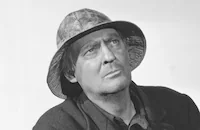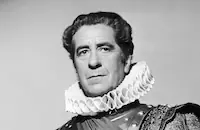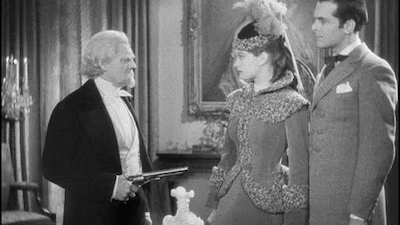The Little Colonel

Brief Synopsis
Cast & Crew
David Butler
Shirley Temple
Lionel Barrymore
Evelyn Venable
John Lodge
Sidney Blackmer
Film Details
Technical Specs

Synopsis
In Lloydsburg, Kentucky, in the 1870's, Colonel Lloyd tries to stop his granddaughter Elizabeth from eloping with Jack Sherman, who fought for the North. When he fails to dissuade her, he warns that should she leave, she will never be welcome in his house. The couple elopes, and after six years of life in Philadelphia, they come West to seek their fortune. At a frontier outpost, their daughter Lloyd is declared an honorary colonel. Jack goes off to prospect for gold, while Elizabeth, with Lloyd, returns to the cottage her mother left her in Lloydsburg. Colonel Lloyd, upon learning that he has a new neighbor, brings flowers as a welcoming gift, but when he sees that the neighbor is his daughter, he throws the flowers down and leaves without a word. After she sees her mother crying, Lloyd learns about the past from the cook, Mom Beck, who points out that all the Lloyds are stubborn. As Lloyd makes mud pies with two black children on the colonel's property, he pokes her with his stick. She then gets angry and throws mud on his white suit. The colonel chases her, and she hides behind Mom Beck, who tells him that she is Lloyd Sherman. Colonel Lloyd then apologizes, and Lloyd calls him "grandfather." Meanwhile, Swazey, who encouraged Jack in his quest for gold, shoots some gold from a rifle into a rock and then convinces Jack to buy the land on which the rock sits. After seeing a baptism, Lloyd steals some sheets from the colonel's bed and baptizes her young black friend. The colonel comes upon them and takes her to his house to get her clothes dried. Lloyd dresses in a fancy Southern dress from a trunk in the attic, and as she sings a song which her mother taught her that her grandmother used to sing, the colonel imagines his deceased wife accompanying her on the harp. During a Civil War game that they play with toy soldiers, the colonel and Lloyd argue about which salute is the proper one, Union or Confederate. As the argument gets heated, the colonel knocks Lloyd's soldiers off the table, and Lloyd knocks the table over. He then warns her that unless she learns to control her temper she will face much unhappiness, and she agrees to try if he will. Jack returns broke and ill with a fever. The doctor convinces Elizabeth to overcome her pride and send Lloyd to live with the colonel until Jack gets well, but after a confrontation with her grandfather, Lloyd wants to go home. When a representative from the Union Pacific Railroad visits Jack and offers $5,000 for the right-of-way through his property, Jack excitedly sends Elizabeth to the bank to get the deed. Swazey and his partner Hull arrive while she is away and try to buy the deed for what Jack paid them. Jack refuses and they wait for Elizabeth's return. Lloyd comes back to the house and overhears Swazey threaten to kill her father. She then runs through the scary woods to find her grandfather at the overseer's house, but he refuses to help until she calls him a wicked, hateful old man and says that she never wants to see him again. He then rides back with her, and they arrive just as Swazey gets the deed from Elizabeth. The colonel shoots a gun out of Hull's hand and turns the pair over to the sheriff. He then hugs his daughter and shakes hands with Jack. At a celebration that follows, Lloyd gives the colonel the Confederate salute, and he returns the Union one.

Director
David Butler
Cast

Shirley Temple

Lionel Barrymore

Evelyn Venable
John Lodge

Sidney Blackmer
Alden Chase
William Burress
Frank Darien

Robert Warwick

Hattie Mcdaniel
Geneva Williams
Avonne Jackson
Nyanza Potts

Bill Robinson

David O'brien
Captain C. E. Anderson
Lillian West
Lucille Ward
Frank Hammond
Ford West
Vester Pegg
Marty Faust
John Ince
Arthur Stuart Hull
Frank O'connor
Roland Hamblen
Charles C. Wilson
Harry Strang
Crew
David Butler
S. C. Chapman
William Conselman
William Darling
B. G. De Sylva
Louis De Francesco
Natalie Kalmus
William Kernell
William Lambert
Arthur Lange
Arthur Miller
Cyril J. Mockridge
Cyril J. Mockridge
Ad Schaumer
William Skall

Videos
Movie Clip




Film Details
Technical Specs

Articles
The Little Colonel
On the heels of the success of the Temple vehicle Bright Eyes (1934), Fox was looking for new properties to showcase their young star. They found her next project in Annie Fellows Johnston's much beloved children's book The Little Colonel. Published in 1895, it sold over a million copies and Johnston developed the story into a full-fledged series with a dozen more novels. Set in post-Civil War Kentucky, the story follows the adventures of a young girl, the offspring of Confederate and Yankee families, who wins over her cantankerous grandfather. It was just the sort of vehicle custom fit for Temple who excelled at playing precocious young problem solvers. Fox purchased the film rights from Johnston's stepdaughter Mary G. Johnston. Screenwriter William M. Conselman, who would go on to write for six different Shirley Temple films, adapted Johnston's novel to screen.
Director Irving Cummings was assigned to The Little Colonel (1935) but had to drop out to direct retakes for another film. David Butler, who later had great success directing big show business types such as Bob Hope, Doris Day and Will Rogers, was his replacement. Butler had directed Temple in Bright Eyes the year before and collaborated with songwriter turned producer Buddy G. DeSylva, who had been under contract with Fox since 1929. The Little Colonel was billed as "A B.G. De Sylva Production".
Production ran from late November 1934 until early January 1935. The Little Colonel was filmed in black and white with the final scene shot in Technicolor. Lionel Barrymore was cast as Colonel Lloyd and given second billing. By the 1930s, Barrymore had perfected the role of the curmudgeon and did so dutifully for The Little Colonel. It's said that Barrymore flew into a rage when Shirley Temple, who memorized the entire script, fed him a line he had forgotten. Tensions arose on set, but the pair eventually made up. Barrymore had appeared with Temple the previous year in Carolina (1934) and would do so again in Since You Went Away (1944). Other cast members include relative newcomers Evelyn Venable and John Lodge who play Temple's parents. Hattie McDaniel, a few years away from Academy Award-winning performance in Gone With the Wind (1939), portrayed Mom Beck.
The Little Colonel's claim to fame is the legendary staircase dance sequence, a collaboration between tap-dancing legend Bill Robinson and Shirley Temple. The scene in which Robinson demonstrates how to tap dance up the stairs as part of Temple's bedtime routine, was the first time an interracial dance couple performed together in a Hollywood movie. Film historian Donald Bogle calls it "one of the great 'musical' sequences in the history of American cinema... it's one of those Depression-era sequences with a subtext that hard times (including domestic difficulties) can be endured and triumphed over if black and white work together." Staircase dancing was Robinson's signature style, one he tried but failed to copyright under his name.
In an interview with Larry King, Shirley Temple remembered Robinson as "the special man in my life... special friend and special teacher." During rehearsals, Robinson would squeeze Temple's hand once if they were doing very well, twice if they were doing fairly well and three times if they had to start over. A version of the film screened for Southern audiences was edited to remove any shots of Temple and Robinson holding hands. According to professor and historian Miriam J. Petty, "though he was much beloved by the youngster in real life, and though he appeared in more films with Temple than any other individual, Robinson was never depicted hugging or kissing Temple onscreen, as white male actors like Lionel Barrymore... were."
The Little Colonel premiered on February 22, 1935 at the Rialto Theatre in Louisville, Kentucky. It was made for a modest budget and earned $1.2 million at the box office. It received mixed reviews. Film critic Andre Sennwald of The New York Times wrote "[The Little Colonel] seems to be right up to the standard of Bright Eyes and out to bring out the best in every one who sees it." The Temple-Robinson dynamic proved to be such a hit that the duo appeared together in four more films: The Littlest Rebel (1935), Captain January (1936), Just Around the Corner (1938) and Rebecca of Sunnybrook Farm (1938). The Little Colonel has been released on home video in the original black-and-white version with the final Technicolor sequence and a computer colorized version.
By Raquel Stecher

The Little Colonel
Quotes
Trivia
Notes
According to Daily Variety, Irving Cummings was set to direct this film, but he instead was assigned to direct retakes of East River, which was released as Under Pressure (see AFI Catalog of Feature Films, 1931-40; F3.4845), and David Butler replaced him shortly before production began. According to Film Daily, because of his work in this film, Bill Robinson was later assigned to In Old Kentucky (see AFI Catalog of Feature Films, 1931-40; F3.2119). The final sequence of this film, the celebration, was shot in Technicolor. According to New York Times, the sequence, which appears to have been photographed outdoors, but actually was shot in an enclosed stage, presented a problem in that Shirley Temple's dress seemed to change color as she moved across the stage.














